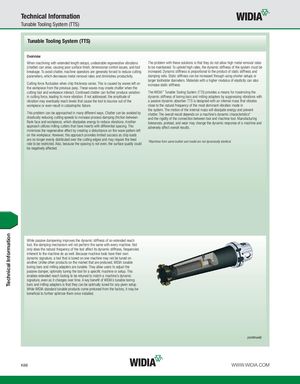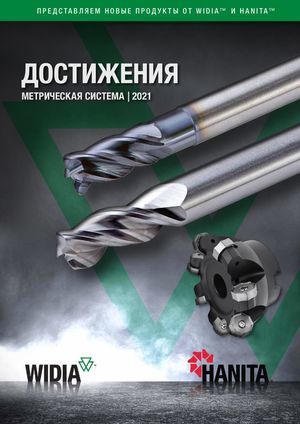Каталог Widia инструментальная оснастка - страница 1102
Навигация

Technical Information Tunable Tooling System (TTS) Tunable Tooling System (TTS) Overview When machining with extended length setups, undesirable regenerative vibrations The problem with these solutions is that they do not allow high metal removal rates (chatter) can arise, causing poor surface finish, dimensional control issues, and tool to be maintained. To uphold high rates, the dynamic stiffness of the system must be breakage. To avoid chatter, machine operators are generally forced to reduce cutting increased. Dynamic stiffness is proportional to the product of static stiffness and parameters, which decreases metal removal rates and diminishes productivity. damping ratio. Static stiffness can be increased through using shorter setups or larger toolholder diameters. Materials with a higher modulus of elasticity can also Cutting force fluctuates when chip thickness varies. This is caused by waves left on increase static stiffness. the workpiece from the previous pass. These waves may create chatter when the cutting tool and workpiece interact. Continued chatter can further produce variation The WIDIA™ Tunable Tooling System (TTS) provides a means for maximizing the in cutting force, leading to more vibration. If not addressed, the amplitude of dynamic stiffness of boring bars and milling adapters by suppressing vibrations with vibration may eventually reach levels that cause the tool to bounce out of the a passive dynamic absorber. TTS is designed with an internal mass that vibrates workpiece or even result in catastrophic failure. close to the natural frequency of the most dominant vibration mode in the system. The motion of the internal mass will dissipate energy and prevent This problem can be approached in many different ways. Chatter can be avoided by chatter. The overall result depends on a machine’s dynamic characteristics* drastically reducing cutting speeds to increase process damping (friction between and the rigidity of the connection between tool and machine tool. Manufacturing flank face and workpiece), which dissipates energy to reduce vibrations. Another tolerances, preload, and wear may change the dynamic response of a machine and approach utilizes milling cutters that have inserts with differential spacing. This adversely affect overall results. minimizes the regenerative effect by creating a disturbance on the wave pattern left on the workpiece. However, this approach provides limited success as chip loads are no longer evenly distributed over the cutting edges and may require the feedrate to be restricted. Also, because the spacing is not even, the surface quality could*Machines from same builder and model are not dynamically identical. be negatively affected. While passive dampening improves the dynamic stiffness of an extended reach tool, the damping mechanism will not perform the same with every machine. Not only does the natural frequency of the tool affect its dynamic stiffness, frequencies inherent to the machine do as well. Because machine tools have their own dynamic signature, a tool that is tuned on one machine may not be tuned on another. Unlike other products on the market that are pretuned, WIDIA tunable boring bars and milling adapters are tunable. They allow users to adjust the passive damper, optimally tuning the tool for a specific machine or setup. This enables extended reach tooling to be retuned to match a machine’s dynamic signature, even as it changes over time. A key benefit of WIDIA’s tunable boring bars and milling adapters is that they can be optimally tuned for any given setup. While WIDIA standard tunable products come pretuned from the factory, it may be beneficial to further optimize them once installed. (continued) K66 WWW.WIDIA.COM Technical Information
 Каталог Widia достижения 2021
Каталог Widia достижения 2021 Брошюра Widia решения для аэрокосмической промышленности
Брошюра Widia решения для аэрокосмической промышленности Брошюра Widia техническое руководство
Брошюра Widia техническое руководство Каталог Widia токарный инструмент 2020
Каталог Widia токарный инструмент 2020 Каталог Widia цельные концевые фрезы
Каталог Widia цельные концевые фрезы Каталог Widia техническое руководство по разверткам
Каталог Widia техническое руководство по разверткам